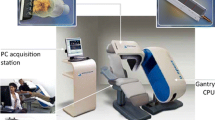Abstract
Digital Flashing Tomosynthesis (DFTS) represents a technique for three-dimensional (3D) coronary angiography. Four ECG-gated simultaneously flashed X-ray tubes generate a multiperspective digital substraction image as DFTS multiangiogram for 3D reconstruction and visualization. Computerized morphologic and morphometric quantitative analysis can be performed including videodensitometry.
Postmortem coronary angiography of 30 human hearts with suspected coronary artery disease was performed by 35-mm cine technique and by DFTS. The results of angiographic measurements in 50 stenotic arterial segments were compared with the histologic reference and show excellent regression results with correlation coefficients of more than 0.95 (p≲-0.0001). No significant differences in standard errors of estimates between the techniques were found. DFTS yields an accuracy in depiction of the coronary arteries and angiographic estimation of arterial lumen equivalent to 35-mm cineangiography. DFTS images can be directly used for visual interpretation and for computerized morphologic and morphometric quantitative analysis. DFTS technology reduces the amount of radiation exposure, the amount of contrast medium, and the time of the procedure. DFTS offers the possibility to obtain 3D images of the coronary artery tree.
Similar content being viewed by others
References
Hounsfield GN. Computerized transverse axial scanning (tomog.),Pt. 1: description of system. Br J Radio 1973; 46: 1016–22.
Weiss H, Klotz E, Linde R, Rabe G, Tiemens U. Coded aperture imaging with X-rays (flashing tomosynthesis). Opt Acta 1977; 24: 305–25.
Nadjmi M, Weiss H, Klotz E, Linde R. Kurzzeittomosynthese — klinische Erfahrungen. Röntgenpraxis 1981; 34: 247–52.
Woelke H, Hanrath P, Schluter M et al. Work in progress. Flashing tomosynthesis: a tomographic technique for quantitative coronary angiography. Radiology 1982; 145: 357–60.
Becher H, Schluter M, Mathey DG et al. Coronary angiography with flashing tomosynthesis. Eur Heart J 1985; 6: 399–408.
Haaker P, Klotz E, Koppe R, Linde R, Mathey DG. First clinical results with digital flashing tomosynthesis in coronary angiography. Eur Heart J 1985; 6: 913–20.
Haaker P, Klotz E, Koppe R, Mathey DG, Stiel LG, Stiel GM. Three-dimensional coronary angiography with digital flashing tomosynthesis. In: Schneider GH, Vogler E, eds. 5. Grazer Radiologisches Symposium, Springer-Verlag, 1987;765–73.
Stiel GM, Stiel LG, Mathey DG et al. Digital Flashing Tomosynthesis (DFTS) — an alternative of CINE-technique in coronary angiography. Eur Heart J 1988; 9: Suppl 1:278.
Stiel GM, Stiel LG, Mathey DG et al. Digital Flashing Tomosynthesis (DFTS) — an alternative of cine technique in coronary angiography. Circulation 1988; 78: Suppl II: 11–399.
Mistretta CA. Digital subtraction angiography. The shape of things to come. Diagnostic Imaging 1982; 130: 36–40.
Stiel GM, Stiel LG, Donath K, Mathey DG. Entfaltungsfixation der Koronararterien mit einem neuartigen Kunststoff-Kontrastmittel-Gemisch für die postmortale Koronarangiographie und Anfertigung von Säge-Schliff-Präparaten. Z Kardiol 1987; 76: Suppl 1: 28.
Brown BG, Bolson E, Frimer M, Dodge HT. Quantitative coronary arteriography. Estimation of dimensions, hemodynamic resistance, and atheroma mass of coronary artery lesions using the arteriogram and digital computation. Circulation 1977; 55: 329–37.
Donath K, Breuner G. A method for the study of undecalcified bones and teeth with attached soft tissues. The Sage-Schliff (sawing and grinding) technique. J Oral Pathol 1982; 11: 318–26.
Devijver PA, Ronse C, Haaker P, Klotz E, Koppe R, Linde P. Pseudomask technique for digital subtraction angiography. Proceedings Mustererkennung 1984 DAGM/ OAGM Symposium Graz, Oktober 1984. Berlin: Springer-Verlag, 1984: 230–6.
Author information
Authors and Affiliations
Rights and permissions
About this article
Cite this article
Stiel, G.M., Stiel, L.S.G., Donath, K. et al. Digital Flashing Tomosynthesis (DFTS) — A technique for three-dimensional coronary angiography. Int J Cardiac Imag 5, 53–61 (1989). https://doi.org/10.1007/BF01745232
Accepted:
Issue Date:
DOI: https://doi.org/10.1007/BF01745232




